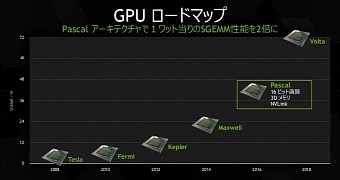We all know the upcoming Pascal architecture, and how it promises to catch up with AMD's HBM Fiji GPU and all that. What we don't know, and even care less, is when and what will be NVIDIA's post-Pascal architecture, the Volta.
Set in a distant future, in times of great competition between HBM-based GPUs from AMD and NVIDIA, the Volta GPU is officially set to see the light of day in 2018, two years after the Pascal has probably been released in 2016.
Apparently, NVIDIA released a new roadmap layout for its upcoming GPUs in Japan, that confirms the industry's belief that Pascal will come out in 2016 and will be followed by the Volta design in 2018.
As previously announced, the future GPU will be built at NVIDIA's long-term fab partner TSMC using the 16nm FinFET process technology. Apparently, the Volta was expected to arrive in 2017, and now it seems to have been postponed for a year.
Not much is known at the moment about the future Pascal GPU specs, except that it will feature a new GP100 graphics processor generation and a new HBM second-generation memory stacking technology as well, with at least double the available memory in current HBM cards from AMD, reaching around 16GB of SK Hynix chips. According to Wccftech, the new GPU will feature around 17 billion transistors and will reach around 1TB/s bandwidth.
Volta gets pushed back while NVIDIA expects to rely on Pascal for three years
Most of it is speculation, of course, since there is nothing officially known from NVIDIA except that the new Pascal will arrive with NVLINK (next-generation Unified Virtual Memory link) and it will bring Gen 2.0 Cache coherency, meaning 5 – 12 times the bandwidth of a regular PCIe connection.
In other words, there won't be any bottleneck anymore between high-performance CPUs and graphics cards. This NVLINK interconnect will allow multi-processors to be connected inside HPC blocks which will provide faster speeds than traditional PCI-e Gen3 lanes at 80 GB/s speeds.
With this sort of new technology reaching the consumer market in 2016, it's a complete mystery what Volta will bring. And although it may include some space-age tech, it won't be until 2017 that NVIDIA starts revealing it to us.
UPDATE: Business Korea has announced recently that Samsung will eventually get involved in building HBM 2 chips together with SK Hynix for Pascal after it previously announced the contrary. The old article has been deleted, however, together with its cached version.

 14 DAY TRIAL //
14 DAY TRIAL //